THE ODEON ISLEWORTH
DIDN’T THIS BUILDING USED TO BE A CINEMA?
PART THREE: THE ROLLS-ROYCE OF TROLLEYBUSES
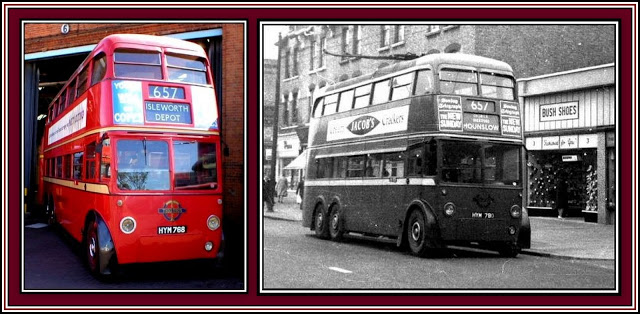 Class Q1 Trolleybus
Class Q1 Trolleybus
BUT 9641T Chassis by British United Traction (B.U.T) and
Body by Metro Cammell Weymann (M.C.W.) with three axles
The terminus of the 81 bus was at Hounslow Bus Depot. Here many RTs were housed and although I only had a passing interest, at that time, in this bus, I did go inside the depot and look at what was there.
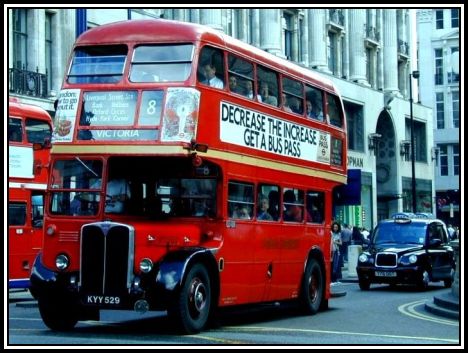 RT 1702 on the Number 8 route going along Oxford Street towards Victoria Station
RT 1702 on the Number 8 route going along Oxford Street towards Victoria Station
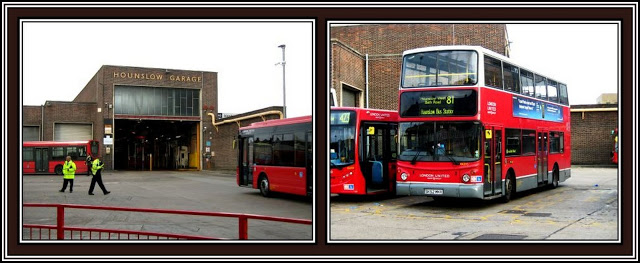 Hounslow Bus Garage in November 2011
Hounslow Bus Garage in November 2011
London Transport authorities made it clear that no trespassers were allowed on their property. This was obviously a good rule since the depot was a working place where buses were driven from place-to-place during servicing. However, when one is young one is not always aware or even cares for that matter about the reasons why one is barred from doing as one chooses. Like my friends, we took no notice of these notices and took our chances and tried to creep inside. Sometimes I was lucky and I was able to explore a garage or depot without interruption; other times I was seen and told to get out; occasionally a worker proved especially nasty and insisted that I go with him to the office. Here I was made to wait to be seen by someone in authority who told me that I was trespassing and that I could be fined, and so on. None of their words carried any weight with me and once I was freed I generally began planning my next assault. I became very cunning in my quest to visit certain depots, as I will describe.
I had come to Hounslow that day not to explore the treasures of its Bus Garage, but rather those housed at the Isleworth Depot, a little further along the London Road. I had never seen a trolleybus belonging to this depot before this visit. In fact I had only seen a few of the trolleybuses that serviced the routes of West London. This was going to prove to be an exciting day.

The reader may wonder where the allure and the charm of these particular trolleybuses lay. Wasn’t a trolleybus like the rose – a trolleybus is a trolleybus is a trolleybus? What made these trolleybuses more special than those that I had grown up with that serviced the 653 route or those that I traveled on to Clerkenwell? The answer is nothing made them more special, as all of London’s trolleybuses were special to me. However, there were two reasons that made it necessary for me to seek out these buses.
Firstly, since the trolleybuses in service at Isleworth Depot were previously unseen, I naturally had a certain interest to see them, and secondly, and perhaps the most important reason for traveling to Isleworth Depot, was that at that time the trolleybuses in service were of the Class Q1, which meant they were 8 feet wide, whereas those trolleybuses that I had previously seen were 7 feet 6 inches in width.
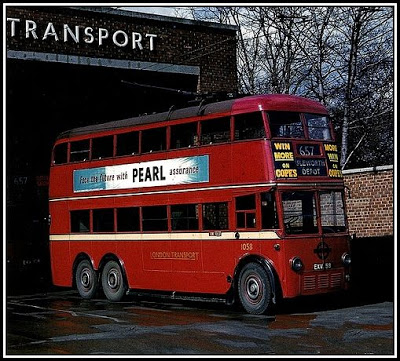 A Trolleybus at Isleworth Depot – Seven Feet Six Inches Wide
A Trolleybus at Isleworth Depot – Seven Feet Six Inches Wide
(This photograph was taken by Depot Cat)
A six inch difference in width between such vehicles may not sound like much, but I can assure the reader that it was noticeable and set this class along with the several other classes of wide trolleybuses apart from the others.
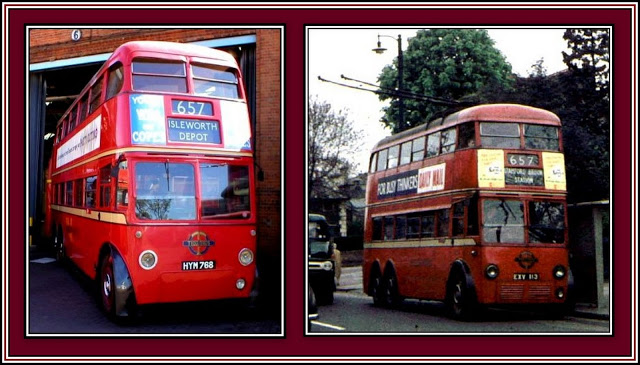 Left: Eight Feet Wide Trolleybus;
Left: Eight Feet Wide Trolleybus;
Right: Seven Feet Six Inches Wide Trolleybus
The first 8 feet wide trolleybuses were the SA1, SA2 and SA3 Classes and numbered 1722-1733 (SA1), 1734-1746 (SA2) and 1747-1764 (SA3). These trolleybuses were built for export to South Africa for service in Durban and were one ton heavier and with a six-inch wider wheelbase compared to the standard London trolleybus and had leather seats and half-shaded glass.
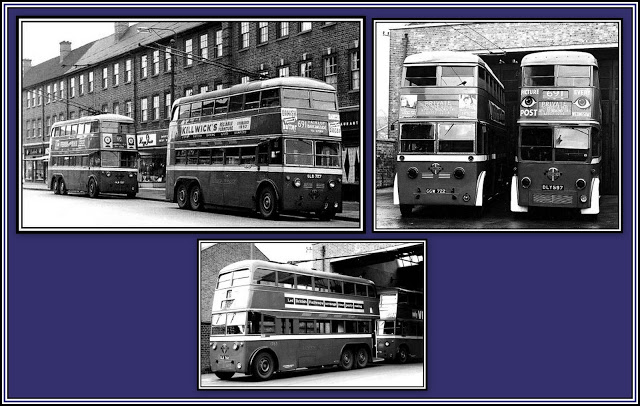 London’s Eight Feet Wide Trolleybuses
London’s Eight Feet Wide Trolleybuses
Upper Left: Trolleybuses of the SA3 (rear) and SA1 Classes;
Upper Right: SA1 Class (left) with a standard trolleybus (right; E1 Class); and
Lower: SA3 Class
(Photographs taken by Ken Blacker)
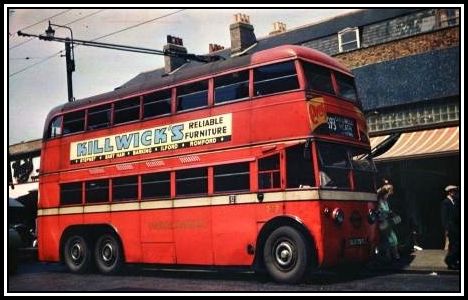 Class SA2 Trolleybus, number 1737
Class SA2 Trolleybus, number 1737
These trolleybuses had a British United Traction (B.U.T.) chassis, BUT 9641T,
and a body built by Metro Cammell Weymann (M.C.W.)
They became part of the London Transport fleet between November 1941 and June 1942, as replacement for the sixteen destroyed and for those withdrawn as a result of damage during the Second World War. Classes SA1 (12 buses) and SA2 (13 buses) and had a chassis built by Leyland and a body by Metro Cammell Weyman (M.C.W). Class SA3 (18 buses) differed from the two previous classes in that their chassis were produced by Associated Equipment Company (A.E.C.). Apparently those buses numbered 1730, 1732 and 1733 were withdrawn in 1955 and sold. These trolleybuses looked considerably different from previous trolleybuses operated by London Transport Executive, which was the name of the company that was formed with the nationalisation of the numerous companies operating the buses servicing London prior to 1948 and which continued until 1962 when it was replaced by the London Transport Board. All of the trolleybuses belonging to the SA1, SA2 and SA3 Classes were housed at Ilford Depot.
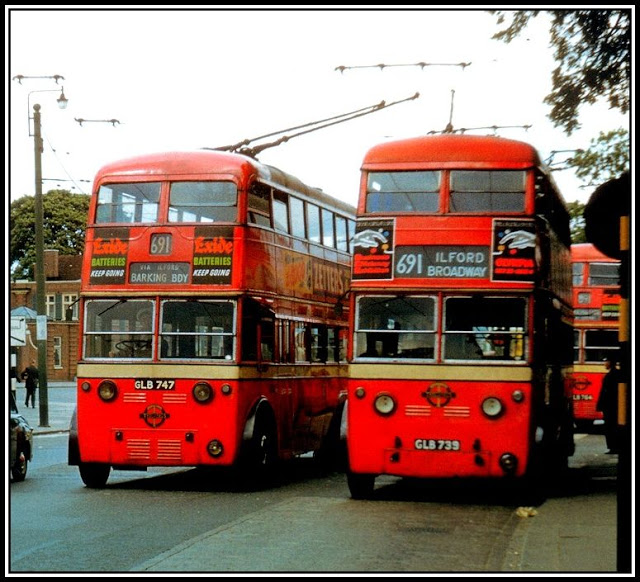 London’s First Eight Feet Wide Trolleybuses
London’s First Eight Feet Wide Trolleybuses
Trolleybus number 1747 of the SA3 Class (left) and
Trolleybus number 1739 of the SA1 Class (right)
(Photograph taken by Frank Mussett)
The Q1 Class consisted of London’s only post-war produced trolleybuses and was often referred to as the Rolls Royce of trolleybuses. The trolleybuses had a chassis built by British United Traction (B.U.T.), a company jointly owned by A.E.C. and Leyland) and a body by Metro Cammell Weymann (M.C.W.) and were introduced in two batches. The first (77 buses) entered service at the Fulwell Depot in 1948 and were numbered 1765 to 1841. These vehicles replaced the Diddlers that had been operating at the depot since their introduction by the London United Tramway Co., Ltd. on 16th May, 1931 for service on routes 601-605. Some of this batch of Q1 Class trolleybuses were also used on the 607 route and were housed at Hanwell Depot. The second batch (50 buses) entered service in May 1952 and numbered from 1842 to 1891.
 Class Q1 Trolleybus – Number 1768
Class Q1 Trolleybus – Number 1768
(This photograph was taken by Roy Northcott and appears here with his permission)
Class Q1 trolleybuses did not only run on London streets, but were also part of the Newcastle-upon-Tyne and Glasgow fleets. The Newcastle trolleybus system opened on 2nd October, 1935 and was to replace the trams. Eventually the system operated 28 routes with a maximum total of 204 trolleybuses of which seventy were Class Q1 trolleybuses that came into service in 1948. These trolleybuses were essential identical to those in London, but did have some interior differences, such as different seat covers and polished wooden fittings. The system eventually closed on 2nd October 1966 and was replaced by diesel buses.
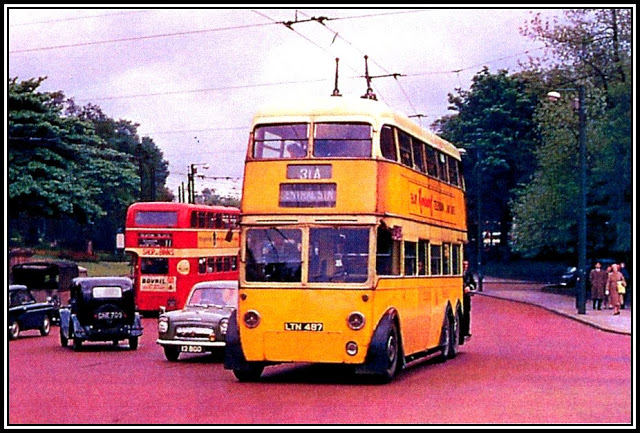 A Newcastle Class Q1 Trolleybus
A Newcastle Class Q1 Trolleybus
Glasgow took charge of thirty-four Class Q1 trolleybuses in 1949. The Glasgow trolleybuses were fitted with their own specific destination window at the front, but were otherwise identical to the London ones. Glasgow ordered another thirty Class Q1 trolleybuses, however these buses had Daimler chassis giving them a slightly longer front overhang than the earlier variety.
——oooOOOooo——
The following information on Glasgow Class Q1 trolleybuses was provided by Geoff Bannister:
When the trolleybuses were introduced in 1949, a new livery of green lower panels with cream between decks with orange relief bands was used. The trolleybuses were also delivered with a form of the London Transport trolleybus roundel on the front. After some time, London Transport objected and the roundel was removed.
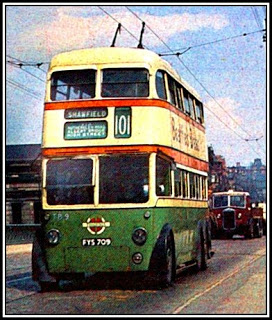 Trolleybus 9 is seen here in 1949 crossing Albert Bridge in Glasgow.
Trolleybus 9 is seen here in 1949 crossing Albert Bridge in Glasgow.
This photograph is credited to C. Carter.
This view of Trolleybus 23 is taken in 1955. Note that the roundel has gone
and a lighter green is being used on the lower panels. The photograph was taken by R. Brook.
This photograph from the early 1960s shows Trolleybus 17 in a later livery
that was standard with the buses. The identity of the photographer is unknown.
——oooOOOooo——
Unfortunately in 1954 London Transport made the decision to withdraw its trolleybus system in favour of the diesel bus, the Routemaster, RM. The replacement of the trolleybus was to take place in thirteen stages with the Q1 trolleybuses being planned to remain in service until the late 1960s, but following negotiations with companies in Spain, their withdrawal was brought forward to November 1960 and 125 of these trolleybuses were sold and made ready for export. The last Class Q1 trolleybus to run in West London was trolleybus number 1812 and ran on route 607 from Uxbridge to Hanwell Broadway on 8th November, 1960. This trolleybus was taken to Poplar Depot for storage until 24th February, 1961, when it and other Class Q1 trolleybus émigrés, numbers 1775,1781, 1810, 1821 and 1829, were transported to St. Katherine Dock in the Port of London and loaded aboard the M.V. Pozarica and began a journey to Spain where they were to join the Compania de Trolebuses Santander-Astillero (CSTA). A total of 125 Class Q1 trolleybuses were also exported to Spain and went to a total of nine trolleybus systems.
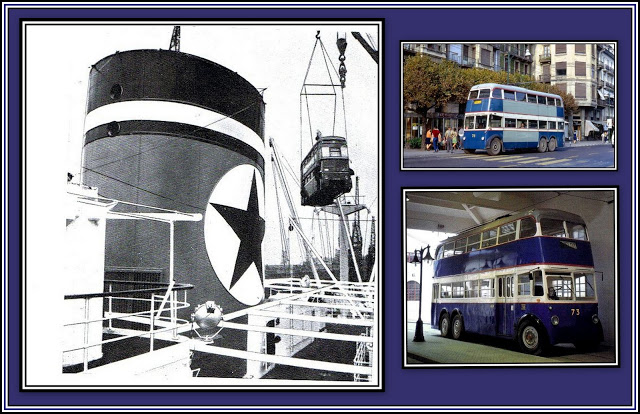 Left: Class Q1 Trolleybus being loaded for export to Spain
Left: Class Q1 Trolleybus being loaded for export to Spain
Right: In service in Spain
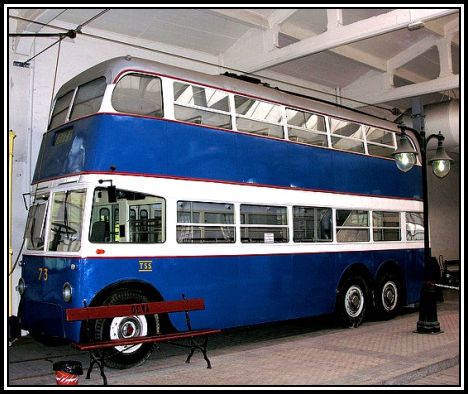 One-time registration number 1837, sold to Tranvia de Zaragozas and now preserved at the Basque Railway Museum in San Sebastian (painted in that city’s livery although it never operated there; TSS on the side of the trolleybus stands for the name of the company, Tranvia de San Sebastian).
One-time registration number 1837, sold to Tranvia de Zaragozas and now preserved at the Basque Railway Museum in San Sebastian (painted in that city’s livery although it never operated there; TSS on the side of the trolleybus stands for the name of the company, Tranvia de San Sebastian).
Like all Spanish exports, it had the platform switched to the other side, but retained right-hand drive.
The Class Q1 émigrés were in service in Spain until 1978. Apparently, it seems that they did not do as well as they had in London. This was the result of a variety of reasons. Perhaps the most important was that the roads were not as good as those of London and the trolleybuses suffered from not receiving as good maintenance as they had once enjoyed. Obtaining spare parts also became a problem as the buses aged since new trolleybuses were no longer being produced. Prior to entering service, they had to undergo some modification to make them serviceable for their new companies. For example, the rear platform was sealed off and a new one made on the right. Later many were converted to one-man-operation with much of the downstairs seating being removed to allow for increased passenger capacity. Throughout their use in Spain, the trolleybuses retained right-hand drive. Finally, the trolleybus industry was destroyed by a law introduced in 1973 by General Franco, the then-head of Spain, which led to its demise and trolleybus replacement with diesel buses.
To fill the void left by the earlier-than-planned withdrawal of the Class Q1 trolleybuses at Fulwell and Isleworth Depots, a number of recently withdrawn Classes K2 and L3 trolleybuses previously housed at Highgate and Finchley Depots were transferred. Apparently these trolleybuses were not in the best of condition since they had been somewhat neglected prior to their withdrawal since it was thought that they were bound for the breakers’ yard. Despite the efforts of the staff of Fulwell Depot charged to maintain them, these trolleybuses were said to remain in a dingy state.
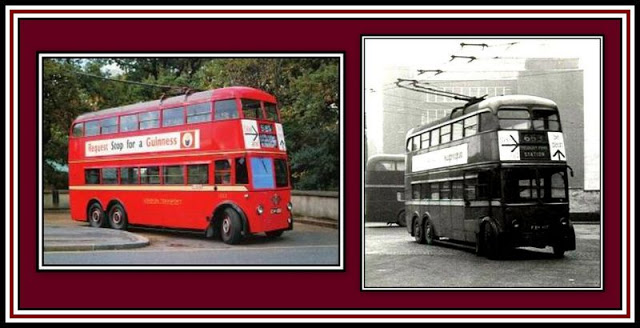 Left: Trolleybus 1253, K2 Class; Right: Trolleybus 1417, L3 Class
Left: Trolleybus 1253, K2 Class; Right: Trolleybus 1417, L3 Class
I remember leaving Hounslow Bus Terminus and walking along the London Road in the direction of Isleworth Depot. As I walked along, I was passed by a number of trolleybuses servicing route 657, which operated from Hounslow to Shepherd’s Bush via Isleworth, Brentford, Kew Bridge, Chiswick, Turhnam Green and Goldhawk Road. The walk proved to be exciting, as every trolleybus that I saw was new to me and each was of the Class Q1 type, truly The Rolls-Royce of Trolleybuses.
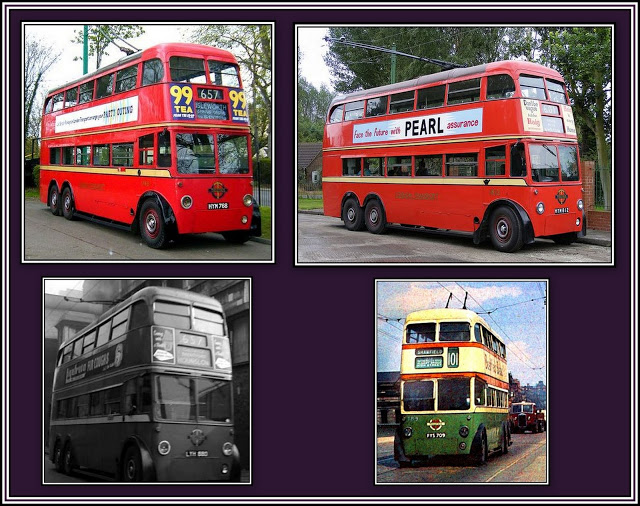 Class Q1, The Rolls-Royce of Trolleybuses
Class Q1, The Rolls-Royce of Trolleybuses
——oooOOOooo——
I would like to thank Geoff Bannister for contributing much towards the technical material in this story, for his help in its production and for allowing the reproduction of his photographs of trolleybuses here.
I would also like to thank Guy Bedminister of the Hounslow Library for providing help and information and Roy Northcott for giving permission for some of his photographs to appear here.
——oooOOOooo——
ISLEWORTH DEPORT
Hounslow Tram Depot – drawing by Graham Lees
Hounslow (Isleworth) Depot was built as a tram depot and its vehicles were among the first to be withdrawn in the conversion to trolleybuses. When it functioned as a trolleybus depot, it serviced only one route, the 657. The first trolleybuses introduced here were 39 of the Class C1 however, due to delays in delivery, 13 short wheelbase Class B2 trolleybuses were borrowed from those destined for the Bexleyheath Depot until the shortfall was made up.
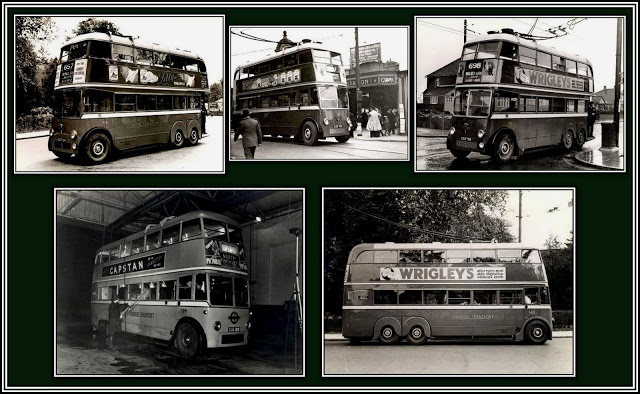 Classes B2 and C1 Trolleybuses
Classes B2 and C1 Trolleybuses
Top Left and Centre: Class B2 trolleybuses on route 657; Right: Class B2 trolleybus at Bexleyheath
Bottom: Class C1 trolleybuses
In May 1952, two new Class Q1 trolleybuses, numbered 1842 and 1843, arrived at the depot presumably for familiarization purposes, as new trolleybuses were scheduled to arrive in September to replace the Class C1 vehicles. At this time, 1842 and 1843 were sent elsewhere and the depot received its new Class Q1 vehicles, numbered 1858-1891. Since the depot needed only 27 trolleybuses at anytime to provide service, the remainder was evidently employed at other depots.
I made my way along the road as quickly as possible, as I was keen to get to the trolleybus depot. Isleworth Depot was built in 1901 and was known as Hounslow Depot however its name was changed in 1950 to avoid confusion with Hounslow Bus Station. It was built as a depot for trams operating Route 57 and once their withdrawal was instigated conversion was made to accommodate trolleybuses.
The walk turned out to be further than I thought. As I walked, I was hoping that Isleworth Depot did not have huge forecourt. One of the problems with getting into a bus depot without being seen was the size of the forecourt. Many depots were set back from the road, which often meant a huge forecourt before it that needed to be crossed. Once you were spotted crossing no-man’s land, access was often denied and entry almost impossible except for the cunning!
What I did when faced with a looming and hostile space before me and with no way of entering the depot without being spotted was to play the innocent! I would present myself at the depot office and seek official permission to enter. Either I would be given permission to enter after being told to be careful and watch out for the buses or else told to hop it! Being told to hop it did not always mean that all was lost
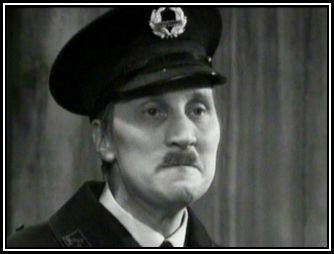 Inspector Blakey from On the Buses – someone to tell you to hop it!
Inspector Blakey from On the Buses – someone to tell you to hop it!
Fortunately the depot office was generally inside the depot. Going to the office meant that the hard part of getting into the depot had been done, as the huge forecourt had been crossed! And so on my way to hopping it, when I came out of the office instead of turning towards the exit, I used to turn toward the garage and go in while walking very quickly. I wasn’t going to let some rude official stop me from checking the buses! Obviously to be successful in gaining entry to a depot, you had to keep your wits about you and move quickly and quietly so as not to rouse attention! Once inside, I used to dodge behind a bus and then begin my tour.
Fortunately Isleworth Trolleybus Depot did not have a large forecourt, which I crossed what there was with ease and then managed to creep inside without being seen. Now I was ready to explore the building. I remember that one side was lined with a row of trolleybuses that were ready for service. Along the other side of the depot were several trolleybuses in a state of disrepair and were obviously being serviced. I remember that I got on one of the trolleybuses and inspected it thoroughly. I walked the length of both decks and sat in a number of seats including the front and the back ones of the upper deck. During my tour, there were times when I heard voices coming from staff members. They were very loud. I suspect that they were teasing and tormenting each other as there was a lot of raucous laughter. I remained still and did not move until their noise faded away. The last thing I wanted was to be thrown out before seeing all of the trolleybuses. Once I had had a good look around and finished my tour, I crept out of the depot as stealfully as I came and escaped to the outside without being spotted. I always found it very satisfying to get in and out of a depot without being noticed.
 Class Q1 Trolleybus – Number 1768
Class Q1 Trolleybus – Number 1768
(This photograph was taken by Roy Northcott and appears here with his permission)
Generally there were several trolleybus routes serviced by a particular depot and which cross at a particular point. This is generally at a busy intersection of several large roads and it is from here that the routes separate. In order to see all of the trolleybuses housed at a particular depot, it is essential for the enthusiast to remain at this junction and wait until each trolleybus in service that day passes. When one is young and when one is excited at seeing new things, such a wait passes in no time at all. Fortunately this was not necessary, as route 657 was the only route serviced by the trolleybuses of Isleworth Depot.
——oooOOOooo——
I would like to thank Geoff Bannister for contributing much towards this story and for allowing the reproduction of his photographs of trolleybuses here.
I would also like to thank Guy Bedminister of the Hounslow Library for providing help and information and Graham Lees for granting permission for his drawing to be reproduced here.
Geoff Bannister has recently added a very interesting section to his website dealing with two trolleybus routes, which includes Route 657.
——oooOOOooo——
THE END OF AN ERA!
YES …… BUT A PHOENIX CAN RISE RISE FROM THE ASHES!
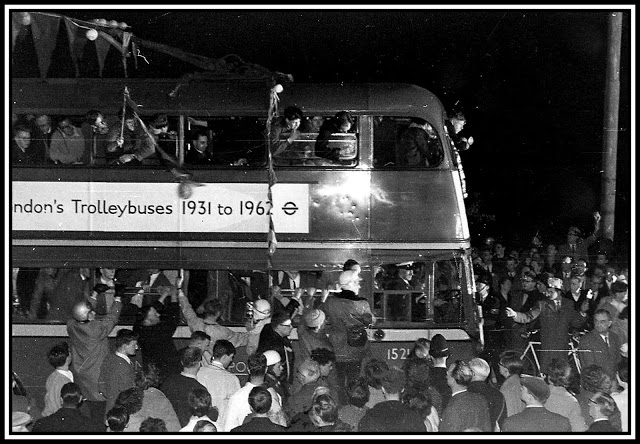 The Last Day – Trolleybus number 1521 – at Fulwell Depot
The Last Day – Trolleybus number 1521 – at Fulwell Depot
(This photograph was taken by Bob Martin)
The trolleybuses that operated route 657 were among the last to be replaced by Routemasters. Once replaced, route 657 became route 117. However, on the final day that trolleybuses ran on London streets, the 8th May, 1962, the trolleybuses were not of the Q1 Class. By this time, London Transport had struck a deal with some Spanish operators and many of the Class Q1 trolleybuses were being exported and route 657 and older trolleybuses previously withdrawn from other areas of London had taken their place.
The last trolleybus to arrive back at Isleworth Depot on 8th May, 1962 was trolleybus 1274 belonging to Class K1. This trolleybus had a chassis and body made by Leyland and had been in operation since February 1939 and was transferred here after it had been withdrawal from service elsewhere.
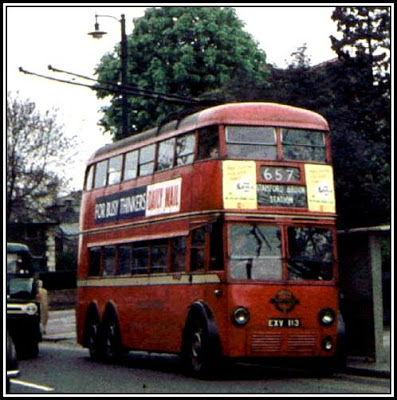 A Class K1 Trolleybus
A Class K1 Trolleybus
Trolleybus Number 1113 in service from October 1938
I remember this trolleybus well, as I had taken it often both to and from school
With the withdrawal of the trolleybus, many depots were converted into diesel bus garages and continued to be operated by London Transport. However several depots including Isleworth were closed and the buildings sold. Following its closure Isleworth Depot has been used by a number of companies including the Postal Service where it was used as a maintenance garage for its vehicles. At present the building is used as an Access Storage Depot. Although the site has undergone a number of incarnations since being a London Transport Depot, its address has remained the same, 592 London Road.
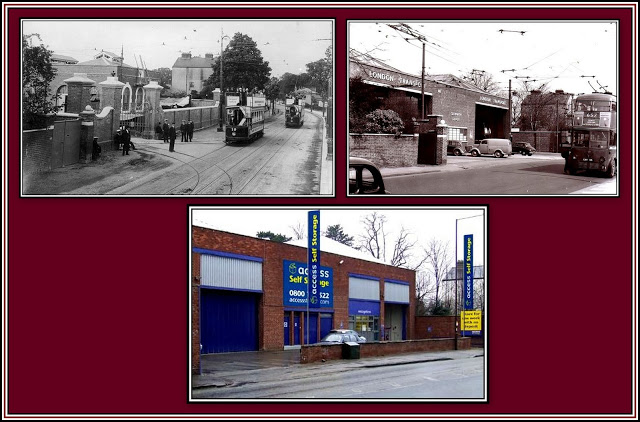 Hounslow Tram-Isleworth Trolleybus Depot
Hounslow Tram-Isleworth Trolleybus Depot
Upper Left: built as a tram depot; Upper Right: converted into a trolleybus depot;
and now, Bottom, an Access Self Storage Depot
——oooOOOooo——
Did you ever see the film, The Yellow Rolls Royce? This film was directed by Anthony Asquith and released in 1965. The film told the story of the wonderful car and of some of its owners. The last sequence begins when the car is found stored in a garage somewhere in the north of the then-Yugoslavia. But fate has not finished with this old relic of a car as of yet. Someone comes and releases it from its fate of decay and rust and after a little work it is ready to resume life once more, this time to transport patriots up into the hills where they prepare to launch a guerilla war against the Nazis. The last scene of the film shows the car being loaded onto a ship for transportation to the United States and finally we see it, gleaming bright once more, as it glides majestically and silently along the highways once again ready to embark on another adventure.
A similar fate awaited a Rolls-Royce of Trolleybuses! The last Class Q1 trolleybus to run in London was on 8th November, 1961. This honor was given to Trolleybus Number 1812 and it ran on route 607 from Uxbridge to Hanwell Depot. Trolleybus 1812 was eventually exported to Spain along with other Class Q1 trolleybuses where it underwent various changes and was transformed into Trolleybus Number 8 of the Santander-Astillero Fleet. There were two trolleybus lines operated by the Santander-Astillero Fleet: an urban line and an inter-urban line, which used several types of trolleybuses including six Class Q1 vehicles between 1961 and 1975.
After negotiations, the British Trolleybus Society brought Trolleybus Number 1812 back to England on 19th June, 1977. The plan was to restore the vehicle and return it to its former form. This meant converting the vehicle back to left-hand drive along with the removal of other changes made. The restoration began in 1999 and was completed in 2001 and the newly restored vehicle was shown to the public at the Transport Museum Sandtoft over the Spring Bank Holiday of that year. Unfortunately, problems with the Differential made it necessary for the trolleybus to be withdrawn from service until a replacement was made and installed, which was completed in 2006.
Just like The Yellow Roll-Royce, Trolleybus Number 1821 has gained another life thanks to the people at the British Trolleybus Society. It is now regularly seen at the trolleybus museums and looks and runs as majestically as it once did on the streets of West London and is a shining example of The Rolls-Royce of Trolleybuses.
——oooOOOooo——
I would like to thank Geoff Bannister for help with the writing of this section and for allowing the reproduction of his photographs of trolleybuses.
——oooOOOoooooo
Recently Geoff Bannister sent with the following information:
I thought that perhaps my Notes on the Spanish Database may to be of interest to some of your readers:
Please note that the date given for withdrawal is when the vehicles were taken out of service by London Transport (LTE) and not the date of shipping to Spain.
Of the 127 Class Q1 Trolleybuses built, 125 were shipped to Spain. Trolleybus 1768 was retained for the London Transport collection. Trolleybus 1841 was fitted with a higher powered traction motor and automatic acceleration equipment and was therefore non-standard.
The companies that originally received these trolleybuses and the number shipped were:
Transportes Urbanos del Gran Bilbao SA 25
Compania de Tranvias de la Coruña SA 12
Trolebuses Coruña -Carballo SA 8
Tranvia Electrico de Pontevedra SA 12
Compania del Tranvia de San Sebastian SA 25
Compania de Trolebuses Santander-Asterillo SA 6
Filovias Interurbanas Reus-Tarragona Y Extersiones SA 2
Tranvias Electricos de Vigo CA 23
Transvias de Zaragoza 12
A number of vehicles changed hands after they arrived in Spain. Tranvias Electricos de Vigo CA bought its Class Q1 trolleybuses with the intention of using them in their tram replacement programme. However once the tramway company lost its franchise and the scheme feel through. As a result, 14 trolleybuses were transferred to other operators: 13 to Coruña and 1 to Coruña -Carballo. The remaining trolleybuses stayed in Vigo, but were never used. Four of the Tranvia Electrico de Pontevedra SA fleet were transferred to Coruña while 3 of the remaining trolleybuses were never operated by Pontevedra. Finally, one of the Zaragoza fleet never entered service.
The following is a list of the final disposition of the Class Q1 fleet:
Bilbao 25
Coruña 29
Coruña –Carballo 9 (1 not used)
Pontevedra 8 (3 not used)
San Sebastian 25
Santander-Asterillo 6
Reus-Tarragona 2
Vigo 9 (not used)
Zaragoza 12 (1 not used)
Coruña converted eight of its trolleybuses into single–deckers. Currently I only have the identity of one. Bilbao converted two of its vehicles into 35-foot long diesel engine buses and again I only have the identity of one.
Therefore, of the 125 Class Q1 trolleybus exported to Spain, 111 were used in passenger service and one of these, 1812, was returned to Britain in 1977, where it was restored and returned into service in 2001 at the British Trolleybus Society site at Sandtoft, near Doncaster.
Geoff Bannister
——oooOOOooo——
Click here to go to PART FOUR: WHAT A REMARKABLE ODEON THIS IS!
——oooOOOooo——
Click here to return to PART TWO: THE ROAD TO HOUNSLOW
——oooOOOooo——
Click here to return to THE ODEON ISLEWORTH Home Page
——oooOOOooo——

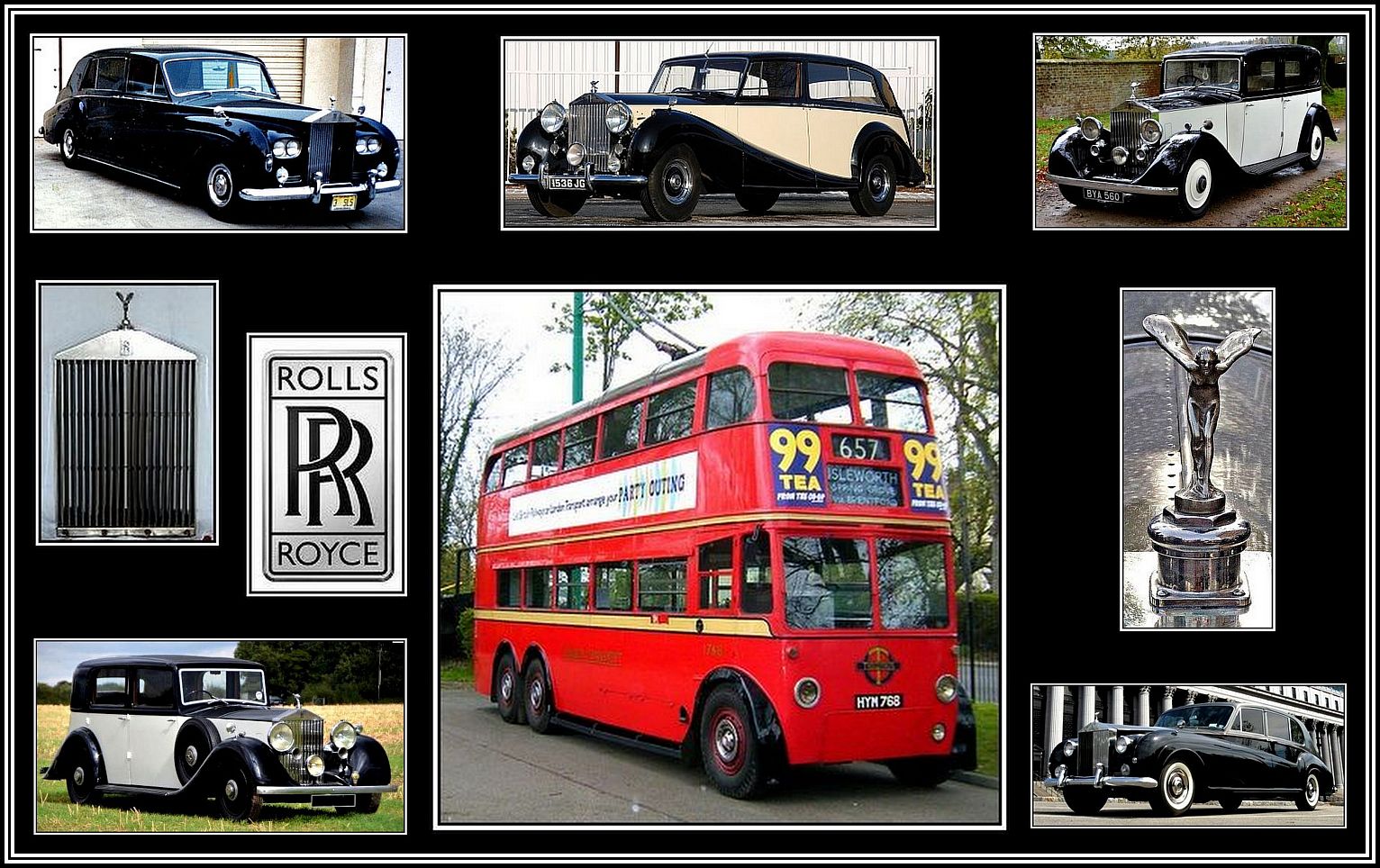
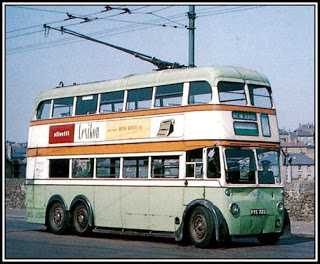
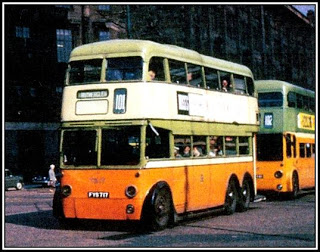
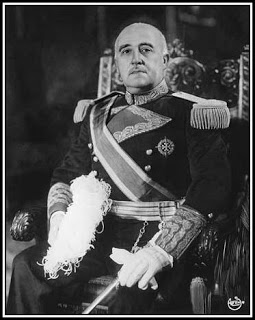
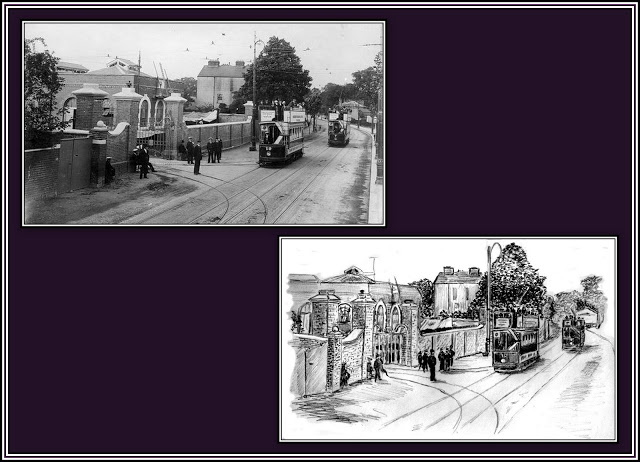
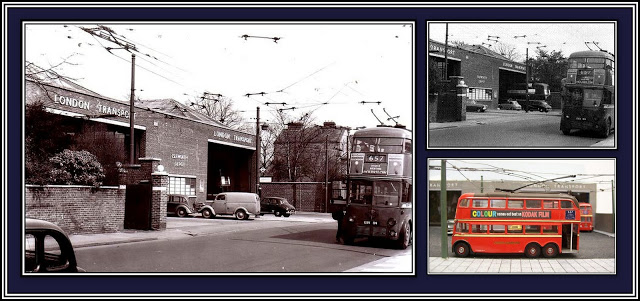
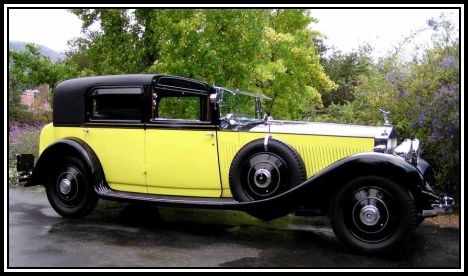
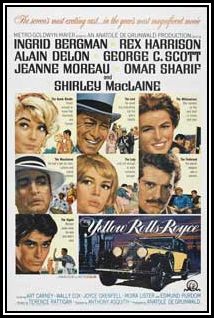
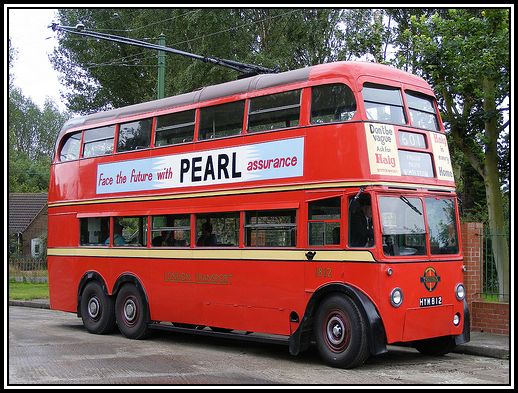
Under the first pair of picture of the Q1 the word is axles not axials 🙁
Thanks for pointing out this error. I have corrected it now.
Oh my goodness. So myself, my older brother Clive and our friend Paul Newell abiding in North Hyde Lane Heston at the time were not the only ones who illegally nipped in bus garages all over London (c.1961-3) on our Red Rovers to get the necessary bus numbers ( and service vehicle numbers) for our Ian Allan books. I think we may have matched your cunning getting in, and often met some really nice LT blokes who would turn a blind eye. Anyway we grew up into big boys (me now about 13) and started collecting plane numbers at London Airport. Years later now as a fully matured grown up adult we hired some offices at Shepperton and guess whose Group owned them — yes the Ian Allan Group! The memories flooded back. About 5 years ago I ventured down Cobham Bus Museum. Not being good with my hands I volunteered and was allowed to hose down and clean an old Country Routemaster (with the electric passenger door on the entry platform).. It came up all sparkly and clean. I was very proud and satisfied with what I did, and what an honour. As an old git recently walking with my partner down the Strand I shouted out to her there’s RT1 there, thoroughly shocking her with her thinking I’d gone mad!
Understand the feeling, however my favourites were trolleys registered ggp 700 to 710, ran on the 630 service and dly that worked from wandsworth on 612 route, living on garratt lane these trolleys were frequent, the ride across mitcham common allowed the driver to open up the speed, sorry to say i collected train numbers at durnsford road with ian allen books, but i spent my pennies riding the ggps from earlsfield to summerstown, the replacement buses never had the class or comfort of the dear old trolley, whilst writing the feltham trams were something else, a luxury vehicle. We would take a 10 to streatham, a few years ago i went to stratstones garage at telford avenue, surprise the tram lines were still in place. We did go to wimbledon where the kingston trolleys hyms were in service, not like our ggps then a trip down the garratt lane to wandsworth more hammersmith trolleys. One thing not often mentioned the spur to wimbledon stadium for dog racing i still cannot understand the decision to rid the roads of these vehicles
What a very interesting article ,I travelled the Uxbridge hanwell route A. Firstly to school and later from Hayes middx to Ealing every day to work,right up until they changed to Routemasters.my abiding memory was the days we got no furthe than Hanwell depot because of smoG ,we all had get off and walk all the way home to Hayes,and be covered in dirty smuts from the smogs ,those were very memorable days.
I remember the terrible smog of the early 1950s and being led home by a charitable blind man. Charles
I left England for life in Australia in 1965 age 12, but even though i was very young i well remember traveling from Tolworth to ( i think ) Kingston on the trolley buses.I must had an interest in all things mechanical even then, as i seem to remember the very snappy acceleration. I’m very glad that there are people who restore such things along with steam locos, slam door carriages and trucks.
Does anyone know the story of the South African’s that ended up at Ilford Depot. I used to travel on these to school everyday. They had obviously been built with front entrances but then converted to the “hop on – hop off” style favoured by L.T. These really were luxury vehicles, leather seats, sunshine windows, 8 feet wide et all. I cannot find anything in the usual sources of information,
Your question is answered elsewhere in the series. Thanks for writing.
A lovely article, I too was an inveterate trespasser, although my nearet LT garage was Morden, only RTs. However I still have my 1st “Red Rover” dated 27 eb 1960 No 204 (Child). I was a frequent passenger on TB routes 604 & 605 between Wimbledon & Raynes Park and rode (for 30yds from the Wimbledon terminus before being ordered off by a policeman – the bus was packed!!) on 1521 on the last service for London trolleybuses. My 1959 Ian Allen book shows that I had visited almost all the Central Area Garages. I only started bus spotting in 1959.
Brian: Thank you very much for visiting my website and for taking the time to comment. As a child, I was NEVER fond of the RT!!! However, as an adult, I soon saw what a truly beautifully designed bus it was. I live in the U.S. now and often see an old RT rolling around. I am always happy when, after checking my old Ian Allen book that I had seen the bus in its prime. Thanks again, Charles
As a young Yank in St. Helens, LCS (part of a USAF family stationed at RAF Burtonwood) I remember the St. Helens-Sutton trolley buses. It didn’t take local authorities to get rid of them; they were replaced by noisy, polluting diesel buses in 1951. Am I wrong to assert that by 1962 the only vertical electrical transport in the UK were the London and Glasgow Undergrounds, the Blackpool tourist trams? (I’m excluding, of course commuter lines.)
Thanks for your comment. I believe that you are correct in your thinking.
Regards. Charles
Great site, I’m glad that some trolley buses have a new life in a museum, I wish we had a system in one or more of our cities, I rode on them in London in the late 50s early 60s. Will we go the full circle? I hope so.
I shall your wish. I would love to see the return of the Trolley Bus in London AND the wonderful RT! But I will not hold my breath!
Regards. Charles